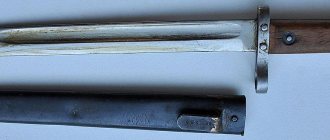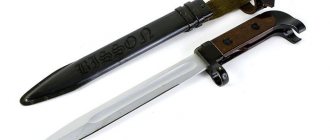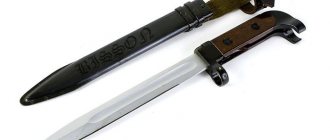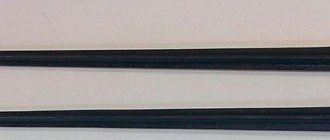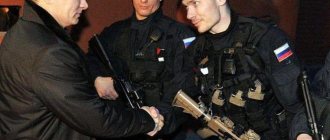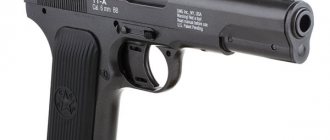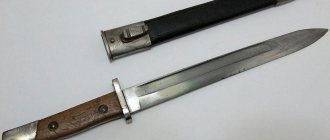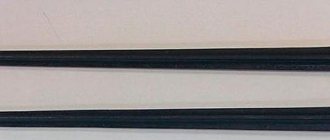The concept of a “scout knife” itself dates back to the Great Patriotic War; until that time, soldiers did not have the right to own any statutory knife. Since ancient times, those who had knives were associated with bandits, and during the USSR this idea was so firmly rooted in consciousness and ideology that there was a ban on carrying any knife other than a kitchen knife. Today it is also believed that if the blade of a knife is longer than the palm of its owner, then it is a bladed weapon, which means it cannot be carried.
Scout knife of the Great Patriotic War HP-40
The history of the HP-40 scout knife
During the USSR period in the 30s, it was prohibited to carry out any manipulations with a Finnish knife. Therefore, even when the Finnish war began, the servicemen were armed with only ineffective sets of bayonets. The Finnish War showed that a serviceman should have a knife in his weaponry with which he can carry out both everyday and combat missions without difficulty. The Finnish army was able to show by its example how any intelligence officer can “take down” a sentry.
During the Finnish War, soldiers were actively re-equipped from rifles to pistols - Shpagin machine guns, which lacked a bayonet. As a result of this, all Soviet machine gunners were deprived of both a bayonet and a knife. And already in 1940, the HP-40 reconnaissance knife entered service with warriors.
An example of this knife was the Finnish puukko knife, although the HP-40 knife differs noticeably. It is known from history that the prototype for this knife was the bandit finca, although in its original form the scout finca knife does not have a protective guard included. The HP-40 knife is 152 mm long, 22 mm wide, and only 2.6 mm thick.
Scout knife HP-40 1940.
With a 40 knife, such a maneuver as a reverse grip is possible, and this can be done thanks to the protective guard. Initially, such knives were exclusively owned by intelligence officers, which is why the knife got its name.
The 40 knife was not affected even by such a long time after the end of the war; it is still quite famous to this day. A large number of companies have taken up the production of various models of HP knives; there is even a scout knife made of Damascus steel.
Prototypes
It is believed that the development of edged weapons for the Red Army was based on the following models:
- A uniform bayonet of the Finnish army, designed by the officer-artist (at that time also the adjutant of the famous Marshal Mannerheim) Akseli Gallen-Kallele. It was an original model that has no analogues in the world. It would be more correct to call it a knife, since it did not have special devices for attaching to a rifle. Knife dimensions (Hackman company): blade 5 mm thick; blade –145 mm; handle length – 105 mm; length (total) of the knife – 255 mm.
- Finnish scout knives. They were developed for Boy Scout organizations. American traditions had a great influence on the shape of the blade: a double-sided guard stop, a blade with a beveled butt (“pike”). They were not in service with the Finnish army, but were purchased with the personal funds of the soldiers.
There is no direct evidence that they became the “ancestors” of the HP-40 model (scout knife). The drawing of the product nevertheless confirms that many elements and the design of the blade resemble the models described above.
The emergence of modifications of the HP-40 scout knife
In Nizhny Novgorod they were not able to master the production of combat knives in the shortest possible time, and at the same level they worked at the same level in Zlatoust.
During the war years, the plant launched more than 260,000 units of this product, which later became popular. Due to the fact that the company could not always produce the required number of knives, a large number of artillery workers began to independently manufacture their own version of these weapons. These knives were very inferior in quality to the metal of the blade; it bent too much and did not hold an edge at all. The advantage of them was the appearance of the handle; it was much nicer than the models from the factory.
Most soldiers figured out how to solve the issue with the appearance of the knife handle; they replaced the factory handles with ones they made themselves from wood, or removed the handles from bad copies of the knife and attached it to their standard knife.
Highlights that represent the 1943 Scout Knife
Already in 1943, an improved transformation of the HP-40 scout knife was released, this became the HP-43 model, which acquired the name “Cherry”, due to the fact that the brand depicted on it was very similar to it. By modifying the product, the developers changed the through shank, the shape and material of the handle, and also added a new guard. It is believed that the process of creating this model was based on the idea of German SS daggers, which have a handle of a similar shape.
Some historical facts have been revealed that do not correspond to previously stated stories about the origin of this knife. The basis for challenging historical facts were:
- in Zlatoust, where a model of this knife was allegedly made, during the wartime there was still no use of plastic for the handle, from which, in fact, it was made;
- all plastic blanks were delivered from Novosibirsk and were turned by hand; at that time they did not yet know how to stamp;
- there is not a single mention of the HP-43 in historical archives;
- in 1943, Zlatoust was going through hard times, and the residents certainly couldn’t afford to start producing new products.
Scout knife HP-43.
Experts believe that the manufacturing technology is similar to a later time; they recall that the first mentions of the “Cherry” knife were during the Afghan War, and then in other hot spots. This unsolved mystery about the time of the knife's appearance adds even more public attention and interest to it.
In many respects the blade is identical to the HP-40.
Description
The blade of the blade is beveled like a clip-point (“pike”). Approximately half the width of the blade is occupied by slopes. In front of the S-shaped guard there is a well-defined heel.
The sheath and handle were made of wood and covered with black paint (for unmasking at night). The blade itself was not subjected to bluing or other coatings.
Recommendations for wearing: on the waist belt, at an angle of 300, on the left side, handle to the right.
Weapons production was established in Zlatoust (“Zlatoust Tool Plant-Combine No. 259 named after V.I. Lenin” - ZiK). The maximum number of products was produced in 42-43:
- 261 thousand pieces in 1942;
- 388 thousand units in 1943, with 271 thousand in the first half of the year.
Both handicraft production and front-line workshops were involved in the production of HP-40. They brought some variety to the standard model: they were decorated, handles were made not only from wood. They replaced them with typesetting options, including those made of plexiglass. The craftsmen did not always adhere to the proportions exactly. The result was the massive appearance of bladed weapons similar to the HP-40.
Characteristics and main functions of the HP-40 knife
The developers of the HP-40 did not have it easy, since they were faced with a program to create a combat knife so that it could be used in everyday life. The knife coped with these tasks with ease, even despite the insignificant weight of the blade; with its help you can simply open canned food or cut something.
The most popular and recognizable feature of this knife was the crosshair; it was made in the shape of an S, but with a rather unusual bend; on the sharp side it was curved towards the blade. Because of this innovation, there were some peculiarities in the grip; well, the butt was directed downward in any case. The knife is 152 mm long and 22 mm wide. Interestingly, the handle was mounted using a push-in mechanism.
Modern models
In the 50s, a bayonet was developed for the experimental Korobov assault rifle, an assault knife was created in Poland, an M1951 combat knife was created in Yugoslavia, and in Czechoslovakia there were several versions of the V07 combat blade.
In the Warsaw Pact countries, edged weapons created according to the HP-40 prototype were in service with armies until the 70s of the twentieth century.
The attractive and well-promoted brand HP-40 (scout knife) served as the basis for the development of many models, including:
- "Cherry". Main characteristics: plastic symmetrical handle, made of impact-resistant plastic (white, black, green); low weight - 150 grams (without sheath); total length 270 mm; blade 158 mm; leather scabbard.
- "Gyurza." Main characteristics: length (total) of the knife 270 mm; blade 155 mm; handle made of stacked leather (there is a model with brass inserts); sheath in two versions - leather or synthetic fabric with plastic inserts.
- "Penal Battalion". Main characteristics: length (total) of the knife 258 mm; blade 140 mm; leather sheath with rigid suspension for a narrow belt.
Handicraft production of the legendary knife
In addition to the main manufacturers, there was also a handicraft production of knives. This has led to the fact that today's collectors have a large number of different modifications.
The production of the HP-40 knife was entrusted to a plant that already had experience in this matter, including the ZiK tool plant. The second was a much larger-scale production.
Drawing of a scout knife no. 40.
The very definition of the HP-40 knife can be said to unite all types of knives of that time, similar in appearance, but at the same time different in material and manufacturing technology.
Tank Blade
The patriotism of the Soviet people during the Patriotic War gave impetus to the production of the HP-40 modification. For the personnel of the Ural Volunteer Tank Corps, a group of workers from the Zlatoust plant produced 3,356 special samples at their own expense.
The HP-40 black knife was somewhat different from the scout knife. They had shortened blades. The shape of the blade is straight, the handle is wooden, as is the sheath. The small iron guard was flat in shape. The scabbard and handle were coated with black varnish (hence the name). The knives were famous for their great strength and sharpness of the blade.
The HP-40 black tank knife became a terrible weapon in the hands of soldiers. Superstitious Germans attributed mystical powers to the blades. The corps was called the "Black Knife Division".
The plant also produced a premium version of the product in small batches. They were decorated with chrome trim on the scabbard and handle. Such blades were received as a gift during the war by Marshal of the Soviet Union G.K. Zhukov and Supreme Commander-in-Chief I.V. Stalin.
Knife fighting methods used in reconnaissance
Various historical sources unanimously claim that every intelligence officer of that time was an excellent master of knife fighting. In fact, in reconnaissance it was permissible to use a knife for a surprise attack or to kill an enemy who was temporarily distracted; based on this, the scouts were trained in two types of knife grips and a couple of classic strikes.
The first method is a regular straight grip, in which the hand tightly squeezes the handle while holding the knife with the blade up. This position made it possible to deliver a strong blow to the enemy in the stomach or under the ribs. The drawback of this grip was the excessive stiffness of the hand and the inability to gain good speed.
The second method was the reverse grip, which was what soldiers often used; the blow was delivered with one hand from top to bottom, and the second scout could cover the enemy’s mouth so that he did not have time to call someone for help.
DIY knife “Cherry”
Do-it-yourself HP 43 is made in several stages:
- First, prepare a drawing of the blade and handle on paper. It is important to observe all dimensions, bevel angles, and roundings. The length of the blade shank should correspond to the size of the handle.
- Then a blade blank with a shank is cut from a piece of steel of suitable quality. This is done with a grinder, clamping the plate with clamps. To remove the formed burrs, the workpiece is processed on a grinding machine.
- Next they make descents on the blade. You need to retreat 10-11 mm from the heel, measure half the width of the blade and remove excess metal using a grinder with a grinding attachment. All that remains is to process the slopes with a belt sander, a file and sandpaper.
- Now the blade should be hardened. This is done in a forge, heating it until it glows yellow if carbon steel is used, and cooling it in oil. Hardening is considered to have been carried out correctly when, after it, the metal does not respond to the effects of a file.
- The next stage is steel tempering to increase its ductility. That is, the blade is heated to 220-250 degrees, kept there for an hour and allowed to cool slowly. The procedure can be performed using an oven. The workpiece is not removed from there until it cools down.
- A guard approximately 2-2.5 mm thick is cut out of a steel plate. It's easier to make it oval. The central hole in the guard should match the width of the shank, that is, it goes right through, but does not dangle in it.
- It is necessary to make a metal frame for the handle, which will separate the guard from the wooden part of the handle. It requires a sheet of steel 10 mm thick so that the wall size is 3 mm.
- The handle is made from hornbeam, this is the simplest and does not deprive the knife of its originality. It must be solid, not made from component parts, cut out according to a sketch. Inside the black hornbeam block, a drill makes a longitudinal hole corresponding in thickness to the shank. External surfaces are brought into the appropriate form using a machine, file, or grinder.
- The weapon is being assembled. The guard must be placed on the tang to the base of the blade. Then a fitting is attached to the wooden part of the handle. The blade is attached to the handle by threading its shank through the hole in the fitting. A nut is attached to the narrow tip protruding from the other end of the handle. It should go through its entire depth, but not protrude too much.
You can make a handle for a knife from cherry yourself in the same way as from hornbeam. You need to take a knot that matches the thickness of the blade and mark the center on the cut. Next, a hole is drilled in it, running along the entire length of the workpiece. A shank with a metal handle already attached to it is inserted into it. A nut is screwed onto the tip of the part, looking out from the other side of the wooden piece.
Now the future handle can be given the desired shape. It is clamped in a vice, processed with a file, on a machine, and planed with another knife. The almost finished handle is polished until smooth. All that remains is to soak it in linseed oil, immerse it in it for 2 days and seal it tightly, and then air dry it for the same time.
We recommend reading about the coolest knives known throughout the world. From the article you will learn about the sharpest, most dangerous and beautiful knives, the ranking of the best knives in the world, the highest quality and most popular in Russia. And here is more information about the types of combat knives.
“Cherry” is a knife with a legend. But it is very difficult to buy a real one, that is, one that is in service with the Russian army; moreover, you will need permission to own it and a lot of money for the acquisition. But it’s easy to get a replica of a weapon, which will be useful in the forest, fishing, at home and will simply become one of the decorations of the collection.
Shooting knife (NRS-2)
The knife differed from all others in that, in addition to the basic functions of a knife, it could also shoot silently. This shooting device is single-shot.
Shooting knife NRS-2.
The main list of work was done on the handle of the blade, and it was here that the firing mechanism was placed.
In the form of a shooting element - a barrel, which is located in the hollow handle of the knife. This device must be recharged for a long time and the barrel must be removed from the handle, for this reason it is used in extreme cases. NRS-2 is recognized as the best knife for scouts and saboteurs.
The name “shooting” tool received already in the process of use, and initially it was called “special scout knife.”
The blade with one and a half sharpening is 158 mm long, and the rest of the part is occupied by a file, which is needed for cutting slings, wires and wires, even those energized up to 400V. A cavity was made at the handle, into which the firing mechanism was subsequently placed; it was fixed by turning the butt plate of the handle.
It was 60 mm long, there were 6 cuts on the barrel, special SP-3 cartridges of 7.62 mm caliber were always used for shooting, this cartridge was previously developed for the MSP silent pistol.
The firing mechanism contained:
- lever - its main task was to cock the hammer;
- a fuse that ensures safety against accidental release;
- release key.
It was necessary to fire shots from the LDC by turning the blade in your direction; the shot was so silent that it could be fired even under water.
Shooting knife NRS-2 in disassembled condition.
Despite all its features, the shooting knife was used quite rarely due to the fact that the units never had enough cartridges for it. In itself, the use of this shooting knife by a scout was quite unique, the difficulty of use was that it was necessary to approach the enemy at a distance of 3 - 5 meters, it was at this distance that a shot was possible.
Price for knife “Cherry”
The price of a product offered for free sale can be 1.6 thousand rubles or 12 thousand rubles, and for weapons with interchangeable blades it reaches 30 thousand rubles. The most affordable tools in this sense are tools from the Vityaz company. True, these are small knives with a blade only 146 mm long, made of 65x13 steel. Products from Knox and Titov and Soldatov fall into the same price category.
The middle segment - knives from A&R and Zlatko companies at a cost of 3.8-4.7 thousand rubles. The most expensive products from Russian damask steel are at least 6 thousand rubles. for the simplest example. All of them belong to the hunting or collection type and do not fall under the definition of “edged weapons” or combat weapons.
Watch in this video the history of the creation and cost of the Cherry knife:
Modern samples of a scout knife
In the image of a scout knife, various knife companies have produced a huge number of different models. The models manufactured at the factories: AIR, Kizlyar and Saro are recognized as the highest quality. In addition, there are many dishonest companies that take on the production of unique replica knives, using any steel for this.
In order to perform the most specific tasks, many different gear and equipment have been developed. It was this that allowed him to remain invisible and survive in a battle with the enemy.
The current vector of development is aimed at reducing the cost of knife production and increasing its versatility.
Nowadays, knife attacks have lost their effectiveness due to the regular use of body armor. The first plan was taken by the cutting ones, with the condition, of course, of increased combat quality, but for this it was necessary:
- change the shape of the blade, sharp angles and bevels appear on it, they are faced with the task of diverging the edges of the wound;
- increase the width of the blade;
- significantly reduce the size of the crosspiece, making it as miniature as possible, the knife will no longer be intended for piercing blows at all, so the finger rest is now useless.
Types of modern models of tactical knives:
1. “Lynx” - it was released in a couple of versions: civilian and award versions. The blade is a dagger with one and a half sharpening, a large cross and a leather handle.
Tactical knife Lynx.
2. DV-1 and DV-2 - made to order for the special forces of the Far East, these models are designed for heavy loads.
Combat knife DV-2.
3. “Punisher” - created in two types “VZMAKH-1” and “Maestro”, the only differences are in the location of the serrated sharpening.
Combat knife Punisher.
4. “Vityaz” - custom-made for special forces, equipped with a heavy blade and a comfortable handle.
Tactical knife Vityaz
This is not the entire list of knives that have been created recently personally for special forces units. Each of them has a characteristic and is capable of helping the owner defend against an attacker.
Previous
Combat knivesKnife "Kondrat"
Next
Combat knivesCombat knives of Russian special forces
Knife manufacturers and product features
There are several popular manufacturers who are developing the Cherry knife. Although the weapons are approximately the same, each has its own characteristics and distinctive characteristics.
A&R
The “Cherry” knife from AiR is made of 95×18 stainless steel, high-alloy. Therefore, the hardness of its blade is 58-59 HRC. The shape of the blade and handle are classic for this type of weapon. Its total length is 266 mm, and the working part is 150 mm. The handle material is quartoprene, and it is green in color and grooved. The thickness of the butt is 2.4 mm. These parameters make the product available to everyone without a permit for edged weapons. Its minimum price is 3.8 thousand rubles.
Knife “Cherry” from Air
Zlatoust
The product from the city of Zlatoust from the Zlatko company is distinguished by its large dimensions:
- blade – 160 mm,
- its width is 24 mm,
- total length – 280 mm,
- The maximum thickness of the butt is 2.4 mm.
It is forged from steel grade 100x13, that is, it has a sharp blade with a hardness of 56-58 HRC, which retains its sharpness for a long time and is not afraid of water and aggressive chemicals. Hence the cost of the gun - from 4.7 thousand rubles. It also does not belong to the category of edged weapons.
Watch in this video a review of the “Cherry” knife from the Zlatoust company:
Knox
The Knox company has created a product with different proportions than classic weapons:
- the blade has a length of 147 cm;
- its thickness is 2.3 mm;
- total size – 260 mm.
Knife “Cherry” from Knox
The handle of the product is black, plastic. The blade steel grade is Japanese AUS-8, which allows you to keep the blade sharp for up to 3 months of active use. In addition, it is quite durable. Disadvantage: it rusts easily from water. Therefore, the price is modest - from 2 thousand rubles. on the company's official website.
Russian damask steel
The Russian Bulat company has several products called HP 43:
- Collapsible with a blade made of U8 steel. It has standard dimensions: the cutting part is 152 mm, the total length is 262 mm, the thickness of the black plastic handle is 30 mm. The quality of the steel makes the tool sharp, holds an edge for a long time and is durable under any type of load. Therefore, its price is 7 thousand rubles.
- Non-separable, with a 65×13 steel blade and a green handle. The dimensions of the component parts of the product are the same as the previous one. But the blade material is cheaper, the quality is slightly lower, so the price is 6 thousand rubles.
- Collapsible with Damascus steel blade. The numerical parameters of this tool are the same as the previous ones. Externally, it differs only in the green handle, but it is also made of plastic. Cost up to 8.2 thousand rubles. increases the quality of blade steel. It is sharper since the hardness of the material is 60-64 HRC.
- Non-separable with a blade made of ELMAX powder steel with a hardness of 60-64 HRC, a green plastic handle. Its dimensions correspond to previous products. But powder steel gives the tool higher strength, wear resistance and corrosion resistance. Therefore, it costs 13.2 thousand rubles.
Knife “Cherry” from Russian Damask Steel, collapsible model
The Russian Damascus Steel line also includes “Cherry” products with interchangeable blades, including different sizes, costing 12-30 thousand rubles. depending on their quantity and quality of steel. There are also knives in the “Fisherman-Hunter”, “Fighter”, “Fisherman-Tourist” configurations at a price of 12 thousand rubles. each.
With hornbeam handle
The weapon, for which a hornbeam was used in the manufacture of the handle, is produced by the AiR company from Zlatoust. The product has traditional dimensions and proportions of parts; the blade is made of 100×13 steel. The pommel of the handle is metal, but the handle itself is black. The cost of such a knife is 5.5 thousand rubles.
There is also a cheaper product with a handle made of carved hornbeam from a lesser known one. Its blade is only 155 mm and is made of 65G steel. The characteristics of the material are such that the knife is easily damaged under impact load. But since the blade is small, this drawback does not appear so much. Therefore, the price of the product is 2.6 thousand rubles.
